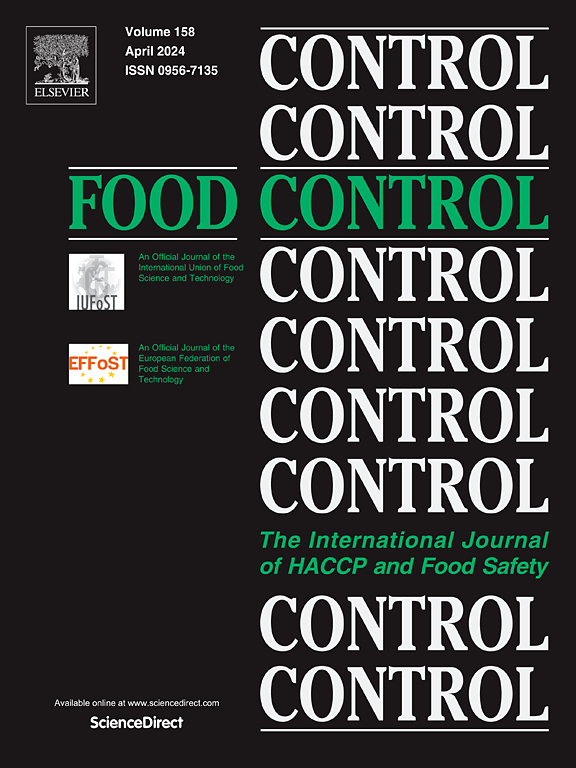Effect of chitosan nanoparticle filled methylcellulose coatings on the polycyclic aromatic hydrocarbon levels of deep-fried meatballs
IF 5.6
1区 农林科学
Q1 FOOD SCIENCE & TECHNOLOGY
引用次数: 0
Abstract
Polycyclic aromatic hydrocarbons (PAHs) are a group of carcinogens commonly found in deep-fried food products. The potential health risks of dietary exposure to PAHs are well recognized. Recent studies have shown that PAHs can penetrate into food through oil uptake, implying potential of edible coatings to reduce oil uptake and then PAHs level. This study investigated the effect of incorporation of 0.2/0.5% chitosan nanoparticles (CSNPs, w: v) into 0.8/0.5% methylcellulose (MC, w: v) for edible coating of meatballs to reduce the PAH levels under deep-frying condition at 190 °C for 5min. The results showed that the deep-fried meatballs coated with 0.5 % MC and CSNPs had the lowest moisture loss (25.87 %), oil uptake (1.29 %), lipid oxidation (0.54 mg MDA/kg) and PAH4 levels (0.73 ng/g). The results suggested that the incorporation of CSNPs into MC edible coating could be an effective method in reducing the PAHs levels and enhancing the quality and safety of deep-fried foods. Future study would incorporate CSNP-MC coatings with antioxidants to further enhance the quality and safety of deep-fried foods and their impacts on sensory properties.
壳聚糖纳米粒子填充甲基纤维素涂层对油炸肉丸多环芳烃含量的影响
多环芳烃(PAHs)是一类常见于油炸食品中的致癌物质。从膳食中摄入多环芳烃对健康的潜在风险已得到公认。最近的研究表明,多环芳烃可通过油的吸收渗透到食物中,这意味着食用涂层有可能减少油的吸收,从而降低多环芳烃的含量。本研究探讨了在 0.8/0.5% 甲基纤维素(MC,w: v)中加入 0.2/0.5% 壳聚糖纳米颗粒(CSNPs,w: v)作为肉丸的可食用涂层,在 190 °C 下油炸 5 分钟对降低 PAHs 含量的影响。结果表明,涂有 0.5 % MC 和 CSNPs 的油炸肉丸的水分损失(25.87 %)、吸油率(1.29 %)、脂质氧化(0.54 mg MDA/kg)和 PAH4 含量(0.73 ng/g)均最低。研究结果表明,在 MC 食用涂层中加入 CSNPs 可有效降低 PAHs 含量,提高油炸食品的质量和安全性。今后的研究将在CSNP-MC涂层中加入抗氧化剂,以进一步提高油炸食品的质量安全及其对感官特性的影响。
本文章由计算机程序翻译,如有差异,请以英文原文为准。
求助全文
约1分钟内获得全文
求助全文
来源期刊

Food Control
工程技术-食品科技
CiteScore
12.20
自引率
6.70%
发文量
758
审稿时长
33 days
期刊介绍:
Food Control is an international journal that provides essential information for those involved in food safety and process control.
Food Control covers the below areas that relate to food process control or to food safety of human foods:
• Microbial food safety and antimicrobial systems
• Mycotoxins
• Hazard analysis, HACCP and food safety objectives
• Risk assessment, including microbial and chemical hazards
• Quality assurance
• Good manufacturing practices
• Food process systems design and control
• Food Packaging technology and materials in contact with foods
• Rapid methods of analysis and detection, including sensor technology
• Codes of practice, legislation and international harmonization
• Consumer issues
• Education, training and research needs.
The scope of Food Control is comprehensive and includes original research papers, authoritative reviews, short communications, comment articles that report on new developments in food control, and position papers.
 求助内容:
求助内容: 应助结果提醒方式:
应助结果提醒方式:


